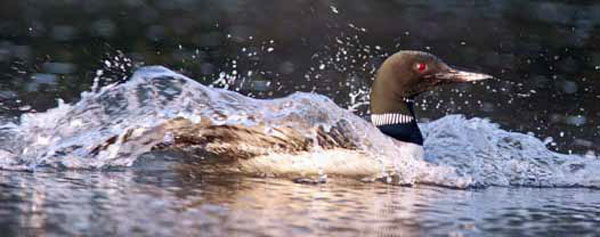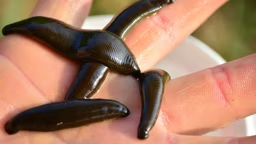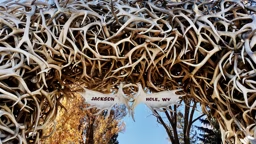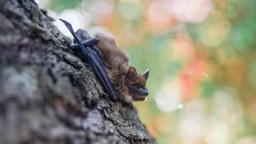As the sun sets, my favorite northern lake becomes smooth and glassy. Tall balsam firs cast perfect reflections onto still water. All is calm as I sit on a rock at the lake’s edge, coveting a cup of tea in the slight chill. In an instant, a lone loon calls out with a long, perfect triplet wail. The sound carries across the lake, echoes from rock to rock and fills my world with a resonating, ancient music that reaches deep into my heart.
Spectacular physical features
There is an uncommon splendor to Gavia immer, the common loon. Their spectacular black-and-white patterned plumage stands out against the iridescent green and violet tones of their heads and necks. Their eyes, a rich, blood red, contrast strongly against their faces. The flat-black beak is a study in sculptural subtlety, an overlapping intricacy of grooves and folds that terminates in a fish-lethal dagger point. The body of a loon is perfectly adapted to a life spent in pursuit of underwater prey.
Plumage as camouflage
When a loon rolls over on the water to preen, we see a brilliant, clean white belly and big, black feet. Its black-and-white speckles are excellent camouflage on sunsparkled waters, and its white belly becomes a different sort of camouflage when viewed against the sky from deep underwater.
Spectacular physical features
There is an uncommon splendor to Gavia immer, the common loon. Their spectacular black-and-white patterned plumage stands out against the iridescent green and violet tones of their heads and necks. Their eyes, a rich, blood red, contrast strongly against their faces. The flat-black beak is a study in sculptural subtlety, an overlapping intricacy of grooves and folds that terminates in a fish-lethal dagger point. The body of a loon is perfectly adapted to a life spent in pursuit of underwater prey.
Plumage as camouflage
When a loon rolls over on the water to preen, we see a brilliant, clean white belly and big, black feet. Its black-and-white speckles are excellent camouflage on sunsparkled waters, and its white belly becomes a different sort of camouflage when viewed against the sky from deep underwater.
Dive, dive, dive!
Loons can, of course, fly in the air, but their form is best suited to the water. Agile swimmers, they pursue fish underwater as superior predators. These great divers have big, webbed feet and powerful leg muscles located as far back on the body as possible. This extreme position gives loons tremendous power in the water, and they’re able to swim great distances between breaths of air.
In most birds, hollow bones and light bodies facilitate flight, but loons use their heavier, more solid bones to advantage when diving.
Birds have a complicated system of gas exchange to the lungs, moving air through a system of stretchy membranous sacs. As divers, loons take advantage of their air sacs, and are masters of air exchange and expert submarine captains in control of buoyancy. In their pursuits of fish, loons may dive to depths well over 100 feet.
A few years ago, I watched from my canoe as a loon surfaced. I heard a peculiar, delicate hissing and was astonished to observe the loon’s body as it inflated somewhat in recovery from its deep dive.
Strong swimming and deep diving also helps loons evade predators; they’re able to dive long before they get their adult feathers and can feed themselves.
The “penguin dance”
A loon’s leg power is also demonstrated in courtship and during times of peak alarm when a loon will literally run in place on top of the water. This “penguin dance” is an explosive display of strength in which the loon swims upward so fiercely as to rear up, cobralike, with its neck curved in a graceful arch, feet pounding the surface of the lake. While the loon’s wings may be splayed out for balance for some of the dance, the most impressive seconds are when the loon’s body is slicked down, wings folded, body raised out of the water on kicking legs.
Loons can, of course, fly in the air, but their form is best suited to the water. Agile swimmers, they pursue fish underwater as superior predators. These great divers have big, webbed feet and powerful leg muscles located as far back on the body as possible. This extreme position gives loons tremendous power in the water, and they’re able to swim great distances between breaths of air.
In most birds, hollow bones and light bodies facilitate flight, but loons use their heavier, more solid bones to advantage when diving.
Birds have a complicated system of gas exchange to the lungs, moving air through a system of stretchy membranous sacs. As divers, loons take advantage of their air sacs, and are masters of air exchange and expert submarine captains in control of buoyancy. In their pursuits of fish, loons may dive to depths well over 100 feet.
A few years ago, I watched from my canoe as a loon surfaced. I heard a peculiar, delicate hissing and was astonished to observe the loon’s body as it inflated somewhat in recovery from its deep dive.
Strong swimming and deep diving also helps loons evade predators; they’re able to dive long before they get their adult feathers and can feed themselves.
The “penguin dance”
A loon’s leg power is also demonstrated in courtship and during times of peak alarm when a loon will literally run in place on top of the water. This “penguin dance” is an explosive display of strength in which the loon swims upward so fiercely as to rear up, cobralike, with its neck curved in a graceful arch, feet pounding the surface of the lake. While the loon’s wings may be splayed out for balance for some of the dance, the most impressive seconds are when the loon’s body is slicked down, wings folded, body raised out of the water on kicking legs.
Taking off and landing like a fighter plane
Impressive as a loon’s legs are in the water, their far-back position simply will not allow a loon to stand upright like a duck. On land, loons are ungainly, pushing their feet against vegetation to creep forward onto a nest.
During flight, the heavy body and small wings that make for skillful diving carry a tremendous burden. To become airborne, a loon needs 50 meters or more of runway on open water. With their feet splashing and wings pounding, loons take off like encumbered bombers. Because of this heavy burden on the wings, a loon flies in a swift, direct line to keep airspeed and avoid a nasty stall.
Loons are pretty good at gliding, so long as they maintain airspeed when losing altitude. Indeed, loons take on a landing with the same tactics used by fighter-plane pilots; they keep a high rate of speed all the way to the landing to avoid stalling.
This “hot” landing entails a thrilling, gliding descent and ends with a cool splash. The loon drags its toes along the water and loses just enough energy to stick a chest-first plunge into the lake.
Despite this heavy load on their wings, I’ve often watched pairs of loons performing a sort of flight duet, a dance of sorts. Both loons, flying fast, draw close together and, at once, raise their wings into a deep dihedral. The two loons, gliding in that deep V, nearly touch. In this fashion they seem suspended in time, soaking up the moment of unity before proceeding onward.
Loons have remained more or less unchanged for more than 25 million years. Despite our wealth of insight into their lives, they are still a constant source of mystery and wonder, and their haunting sounds place us fully into our wild lake experience.
Brian Collins has been enjoying loons peacefully from a canoe since his toddler years. Being good judges of character, they have graciously allowed his camera to peek into their lives. To see more of Brian’s wildlife photos, visit his website, www.imagesinnaturallight.com.
Impressive as a loon’s legs are in the water, their far-back position simply will not allow a loon to stand upright like a duck. On land, loons are ungainly, pushing their feet against vegetation to creep forward onto a nest.
During flight, the heavy body and small wings that make for skillful diving carry a tremendous burden. To become airborne, a loon needs 50 meters or more of runway on open water. With their feet splashing and wings pounding, loons take off like encumbered bombers. Because of this heavy burden on the wings, a loon flies in a swift, direct line to keep airspeed and avoid a nasty stall.
Loons are pretty good at gliding, so long as they maintain airspeed when losing altitude. Indeed, loons take on a landing with the same tactics used by fighter-plane pilots; they keep a high rate of speed all the way to the landing to avoid stalling.
This “hot” landing entails a thrilling, gliding descent and ends with a cool splash. The loon drags its toes along the water and loses just enough energy to stick a chest-first plunge into the lake.
Despite this heavy load on their wings, I’ve often watched pairs of loons performing a sort of flight duet, a dance of sorts. Both loons, flying fast, draw close together and, at once, raise their wings into a deep dihedral. The two loons, gliding in that deep V, nearly touch. In this fashion they seem suspended in time, soaking up the moment of unity before proceeding onward.
Loons have remained more or less unchanged for more than 25 million years. Despite our wealth of insight into their lives, they are still a constant source of mystery and wonder, and their haunting sounds place us fully into our wild lake experience.
Brian Collins has been enjoying loons peacefully from a canoe since his toddler years. Being good judges of character, they have graciously allowed his camera to peek into their lives. To see more of Brian’s wildlife photos, visit his website, www.imagesinnaturallight.com.
Caring for Your Cabin Country Loons
Loons require clean waters, secluded bays, natural shorelines, or undisturbed islands. Here are a few tips to help keep your loons around:
1. When boating in the company of loons, be sure to keep your distance. Loons like their space and don’t deal well with intrusion. Keep close encounters slow and to a minimum. If a loon waves a webbed foot at you, you may think the loon is saying “Hello,” but it’s likely signaling “Enough!” Loons cool their bodies by evaporating water from their big feet. The need to cool off may indicate that the bird is stressed.
2. When you’re cleaning fish at the lakeside, dispose of fish entrails away from the lake. Fish parts attract gulls and eagles, who prey on loon eggs and chicks.
3. Investigate your options for nontoxic fishing tackle, especially replacing lead tackle. Like other aquatic birds, loons
are susceptible to toxic fishing accessories lost in a lake. A single lead sinker gives a lethal dose of lead to a loon.
4. Be a citizen scientist! Keep a journal of your favorite loons. How many chicks do they have from year to year? How many of those chicks survive? How many loons do you see each year? Keeping track of your loons may come in handy if your local conservation agency launches a study.
5. Promote your loons’ needs with your lake association. Posting signs at boat landings and informing others about loons can keep your lake loon-friendly.
6. If your lake is missing nesting habitat but has lots of other things that loons need, consider working with your state’s natural resources department to erect an artificial loon-nesting platform.
To learn more about artificial nesting platforms for loons, see “Help Keep Loons on Your Lake.”
Loons require clean waters, secluded bays, natural shorelines, or undisturbed islands. Here are a few tips to help keep your loons around:
1. When boating in the company of loons, be sure to keep your distance. Loons like their space and don’t deal well with intrusion. Keep close encounters slow and to a minimum. If a loon waves a webbed foot at you, you may think the loon is saying “Hello,” but it’s likely signaling “Enough!” Loons cool their bodies by evaporating water from their big feet. The need to cool off may indicate that the bird is stressed.
2. When you’re cleaning fish at the lakeside, dispose of fish entrails away from the lake. Fish parts attract gulls and eagles, who prey on loon eggs and chicks.
3. Investigate your options for nontoxic fishing tackle, especially replacing lead tackle. Like other aquatic birds, loons
are susceptible to toxic fishing accessories lost in a lake. A single lead sinker gives a lethal dose of lead to a loon.
4. Be a citizen scientist! Keep a journal of your favorite loons. How many chicks do they have from year to year? How many of those chicks survive? How many loons do you see each year? Keeping track of your loons may come in handy if your local conservation agency launches a study.
5. Promote your loons’ needs with your lake association. Posting signs at boat landings and informing others about loons can keep your lake loon-friendly.
6. If your lake is missing nesting habitat but has lots of other things that loons need, consider working with your state’s natural resources department to erect an artificial loon-nesting platform.
To learn more about artificial nesting platforms for loons, see “Help Keep Loons on Your Lake.”



 Brian M. Collins
Brian M. Collins 









